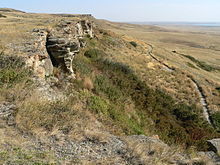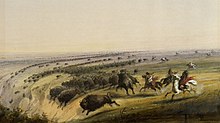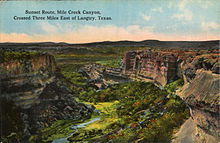
A buffalo jump, or sometimes bison jump, is a cliff formation which Indigenous peoples of North America historically used to hunt and kill plains bison in mass quantities. The broader term game jump refers to a man-made jump or cliff used for hunting other game, such as reindeer.
Method of the hunt

Hunters herded the bison and drove them over the cliff; this process would serve to break the buffalos' legs and render them immobile, though often still alive and in great pain. Tribe members would wait below the jump and then close in with spears and bows to finish the kill. The Blackfoot people called the buffalo jumps "pishkun", which loosely translates as "deep blood kettle". They believed that if any buffalo escaped these killings then the rest of the buffalo would learn to avoid humans, which would make future hunts more difficult.
Due to the large number of buffalo that would be driven over the cliff, the practice has been criticized as having been highly wasteful. Many of the animals driven over the cliffs did not end up getting harvested as most would rot or go to waste. This was due primarily to the primitive tools and harvesting techniques available to indigenous peoples at the time. Such tools and methods made it impossible to harvest so many dead or dying animals fast enough to beat the onset of rotting, and therefore vast amounts of unharvested, wasted carcasses were left to rot out in the open.
Buffalo jump sites are often identified by rock cairns, which were markers designating "drive lanes", by which bison would be funneled over the cliff. These drive lanes would often stretch for several miles.
Buffalo jump sites yield significant archaeological evidence because processing sites and camps were always nearby. The sites yield information as to how the Native Americans used the bison for food, clothing, and shelter. Plains Indians, in particular, depended on the bison for their survival.
In one of his journals, Meriwether Lewis describes how a buffalo jump was practiced during the Lewis and Clark Expedition:
...one of the most active and fleet young men is selected and disguised in a robe of buffalo skin... he places himself at a distance between a herd of buffalo and a precipice proper for the purpose; the other Indians now surround the herd on the back and flanks and at a signal agreed on all show themselves at the same time moving forward towards the buffalo; the disguised Indian or decoy has taken care to place himself sufficiently near the buffalo to be noticed by them when they take to flight and running before them they follow him in full speed to the precipice; the Indian (decoy) in the mean time has taken care to secure himself in some cranny in the cliff... the part of the decoy I am informed is extremely dangerous.
Historical sites


Sites of interest range from Alberta to Texas, including: Head-Smashed-In, Bonfire Shelter, Ulm Pishkun, Madison Buffalo Jump, Dry Island, Glenrock, Big Goose Creek, Cibolo Creek, Vore, Wahkpa Chu'gn (also includes Too Close for Comfort archaeological site), Olsen-Chubbuck Bison Kill Site, and Camp Disappointment of the Lewis and Clark Expedition.
Ulm Pishkun Buffalo Jump is likely the largest buffalo jump in the world. It was used by the Native Americans in the area between 900 and 1500 CE. The cliffs themselves stretch for more than a mile and the site below has compacted bison bones nearly 13 feet (4.0 m) deep, a testament to how many of the killed buffalo went unharvested by tribal peoples. Ulm Pishkun Buffalo Jump is located in First Peoples Buffalo Jump State Park in Cascade County, Montana, north-northwest of the community of Ulm.
Madison Buffalo Jump State Park is a Montana state park in Gallatin County, Montana in the United States. The park is 638 acres (258 ha) and sits at an elevation of 4,554 feet (1,388 m). The park is named for a canyon cliff used by Native Americans as a buffalo jump, where herds of bison were stampeded over the cliff as a means of mass slaughter. This limestone cliff was used for 2,000 years by Native Americans. Madison Buffalo Jump State Park is a day use-only park. It is open year-round for hiking, wildlife observation, and some picnicking.
Camp Disappointment, the northernmost point of the Lewis and Clark Expedition, is among the best-preserved buffalo jumps in Montana, due to its relatively inaccessible location. The creek at the bottom of the cliff periodically exposes bones of animals that were not harvested.
There is a 3-D reconstruction of Charles M. Russell's painting of a buffalo jump on display at the Helena State Capital Museum, Helena, Montana.
See also
- Bison hunting
- Constant Battles: Why we fight
- Food loss and waste
- Game drive system
- Petroform
- Desert kite
References
- A Buffalo Jump Archived November 24, 2014, at the Wayback Machine, Discovering Clark and Lewis, The Lewis and Clark Fort Mandan Foundation
- LeBlanc, Steven (2003). Constant Battles: Why We Fight. New York, NY: St. Martin's Griffin. p. 32. ISBN 9780312310905.
- ^ Mass Kills. Texas Beyond History.
- Wednesday May 29, 1805. The Journals of the Lewis and Clark Expedition (Volume 4). Gary E. Moulton, editor
- Reader's Digest "Mysteries of the Ancient Americas" (The Reader's Digest Association, Inc., 1986) p. 90
- "About the Vore Buffalo Jump". Vore Buffalo Jump. Vore Buffalo Jump Association. 2007. Archived from the original on May 11, 2010. Retrieved August 4, 2009.
- Wahkpa Chu'gn Buffalo Jump
- Ulm Pishkun Buffalo Jump State Historical Monument Park and Center. Archived August 26, 2009, at the Wayback Machine LewisAndClarkTrail.com
- "Madison Buffalo Jump State Monument". Geographic Names Information System. United States Geological Survey. June 1, 1995. Retrieved July 13, 2010.
- ^ "Madison Buffalo Jump State Park". Montana Fish, Wildlife and Parks. Archived from the original on July 10, 2010. Retrieved July 13, 2010.
- Madison Buffalo Jump State Park Archived June 10, 2013, at the Wayback Machine, Montana Official State Travel Site
- "Camp Disappointment" (PDF). National Register of Historic Places. National Park Service. Retrieved May 17, 2015.
| Hunting topics | |
|---|---|
| History | |
| Forms |
|
| Equipment | |
| Game | |
| Infrastructure | |
| By location |
|
| Regulation and conservation | |
| Culture |
|
| Organizations |
|
| Other | |
- Buffalo jumps
- Bison hunting
- Hunting in Canada
- Hunting in the United States
- Archaeology of Canada
- Canadian Prairies
- First Nations history in Canada
- Archaeological sites in the United States
- Western United States
- Native American history
- Indigenous culture of the Great Plains
- Hunting methods
- Stone age sites
- Archaeological sites in Montana